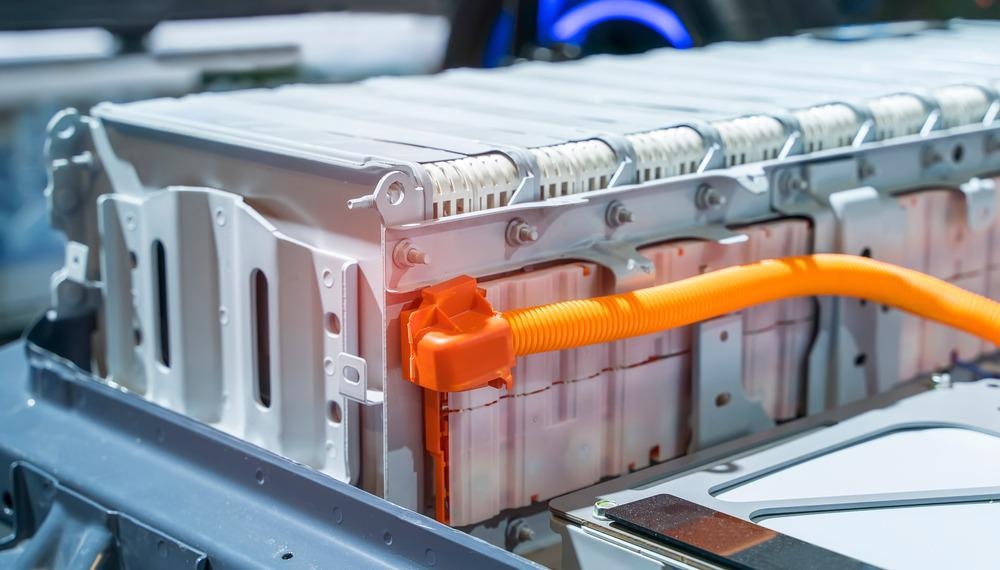A research group led by Prof. Jeff Dahn of Dalhousie University published a novel study in the Journal of the Electrochemical Society that focuses on life cycle performance analysis of anode-free pouch cells, utilizing around 65 various kinds of electrolytes.

Study: Cycling Performance of NMC811 Anode-Free Pouch Cells with 65 Different Electrolyte Formulations. Image Credit: asharkyu/Shutterstock.com
The research states explicitly that liquid electrolytes are the most cost-effective tool for the enhancement of energy density in anode-free pouch cells, especially lithium metal batteries.
Importance of Lithium Metal Batteries
A lithium metal battery with a relatively higher power density and improved reliability is unquestionably the best option for consumer devices and electrically propelled cars. In terms of density concentration and affordability, lithium metal batteries outperform state-of-the-art lithium-ion batteries, creating enormous opportunities. In handheld consumer electronics, lithium batteries are commonly utilized.
Li metal batteries (LMBs) experienced considerable challenges and safety issues during their brief commercialization in the 1980s. Recent breakthroughs in cell physics, however, have sparked interest in LMBs enabled by liquid electrolytes since they constitute a "drop-in" alternative inside the existing LIB architecture, where large monetary expenditures have been invested.
Limitations of Li-Metal Batteries
Lithium metal batteries have various disadvantages and limitations. Huge capacity enhancement, uncontrolled Li topology, dendritic development, quick electrolyte deterioration, and Li supply loss owing to inadequate SEI passivation put a stop to a commercial interest in LMBs, particularly with the emergence of carbonaceous anodes.
Furthermore, a substantial electrolyte overflow ameliorates the issues associated with electrolyte utilization in LMBs, and the use of thick Li foils as counter electrodes provide the cell with an "unlimited" supply of Li while masking the downsides of severe Li inventory loss.
Lithium Metal batteries Liquid Electrolytes
The utilization of ether- or carbonate-based solvents is fundamental to producing LMB liquid electrolyte batteries. The use of high salt density ether-based electrolytes, in particular, has piqued the curiosity of the LMB industry.
How Can Lithium-Ion Battery Manufacturers Conquer Separator Film, Calendering and Coating?
Unlike LIBs, research on LMB electrolytes is still in its early stages; therefore, evaluating electrolyte candidates is both empirically and mathematically critical for progressing the area. As a result, substantial, publicly available databases of LMB liquid solutions are required to support such investigations.
Limitations of Liquid Electrolytes
Liquid electrolytes, although advantageous, have several limitations. Electrolytes are difficult to work with because of Li's sensitivity to the solution and the subsequent Li depletion, as well as spongy Li concentrations that lead to dormant Li and dendrite development. As a result, further development is required to produce electrolytes capable of retaining 80 percent of their capacity after 800 cycles to satisfy the demands of electric cars.
Life cycle results of 65 different electrolyte mixtures are comprised of different additive solutions.
Research Findings
NMC811 pouch cells were utilized in conjunction with electrolytes of various compositions. All life cycle evaluations of the cells were performed at 40 °C with a charge/discharge rate of 0.2C/0.5C between 3.55-4.40 V. To eliminate extra moisture content, all units were sliced open in an Ar glovebox and dehydrated at 120 °C under vacuum for 14 hours.
Ether-based solutions employing DOL, DME, DX, and TTE solvent liquids have been demonstrated to be potential alternatives to standard carbonate-based systems, particularly when combined with LiFSI or LiTFSI salts. The addition of 5% p-toluene sulfonyl isocyanate (PTSI) and Tris(2,2,2-trifluoromethyl) had no effect on specific capacity when compared to the baseline control.
The electrolyte screening revealed that just five electrolyte screenings performed similarly to or marginally better than the control. The introduction of merely 1 wt% LiClO4 resulted in an enhancement in power preservation.
Unsurprisingly, only four mixes improved energy delivery slightly, while the others were damaging to the cell when matched to our reference. Compounds have varied structural features and chemical reactivity, and at varying weight percentages, to cover a wide range of possible additional options.
Limitations
Several imitations regarding this concept were observed. Energy retention trends did not always correspond to the number of additives or co-solvent utilized. Furyl methyl ketone (FMK), MeTHF, and PN, for example, did not reveal a strong association between density and energy preservation. Conventional ether solvents such as DOL and DME, which have previously been proven to successfully cycle Li metal, contradicted the carbonate, dual-salt basis.
In short, achieving an adequate lifespan in anode-free cells with aqueous electrolytes necessitates a tremendous deal of knowledge. The performance of the five blends was somewhat improved compared to the benchmark dual-salt solution, while the other mixtures were deleterious. This dataset demonstrates the difficulties connected with liquid LMB electrolytes and may be used as a resource for academics working in this field.
References
Eldesoky, A. et. al., (2021). Cycling Performance of NMC811 Anode-Free Pouch Cells with 65 Different Electrolyte Formulations. Journal of The Electrochemical Society. Available at : https://iopscience.iop.org/article/10.1149/1945-7111/ac39e3
Disclaimer: The views expressed here are those of the author expressed in their private capacity and do not necessarily represent the views of AZoM.com Limited T/A AZoNetwork the owner and operator of this website. This disclaimer forms part of the Terms and conditions of use of this website.